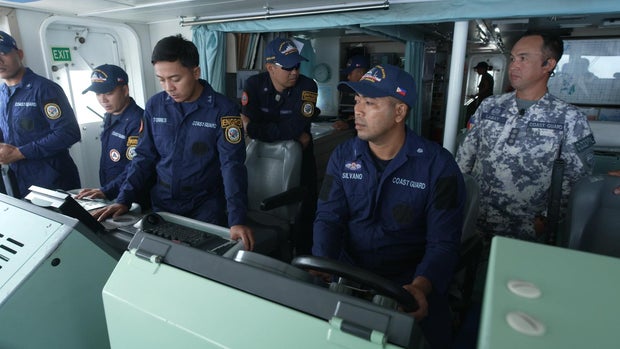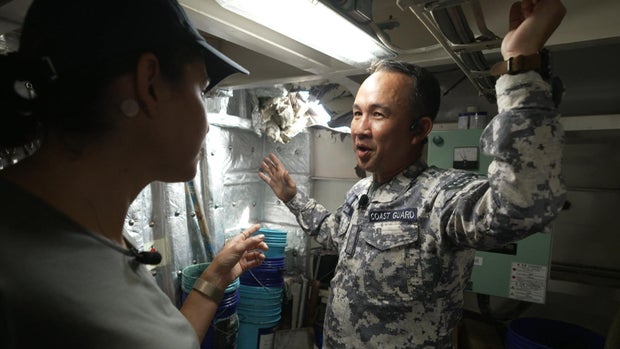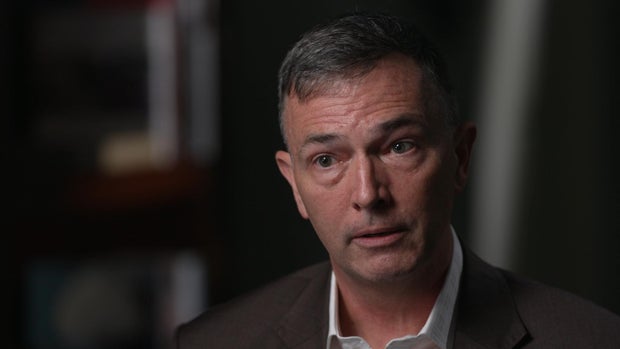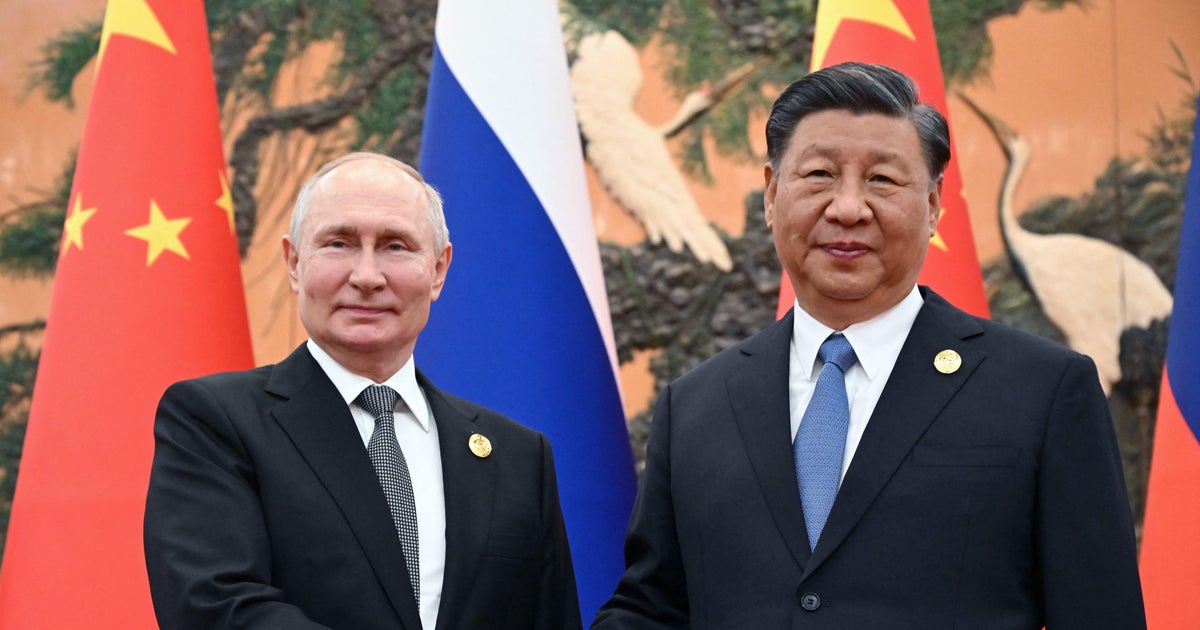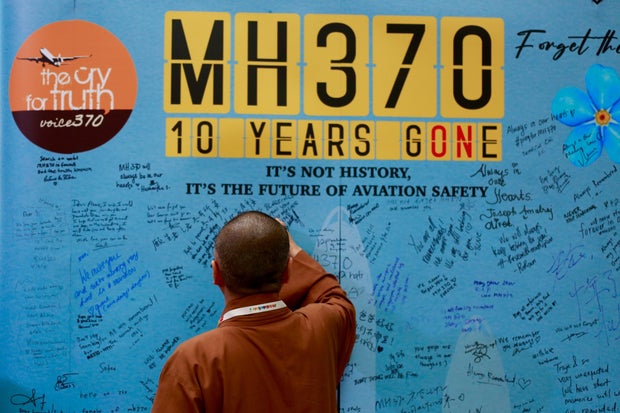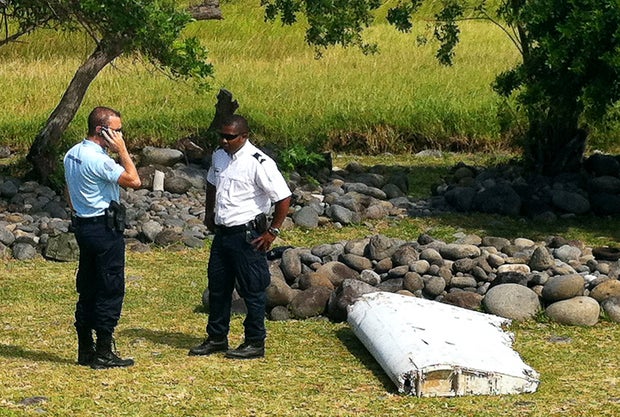CBS News
South China Sea conflict near Philippines could be next U.S.-China flashpoint | 60 Minutes

If there’s going to be a military conflict between the United States and China, the thinking in Washington goes, it will most likely happen if China tries to invade Taiwan. But lately tensions have escalated precariously in another part of the South China Sea-the waters off the western coast of the Philippines where an international tribunal ruled the Philippines has exclusive economic rights. But China claims almost all of the South China Sea, one of the world’s most vital waterways through which more than $3 trillion in goods flow each year. To assert its claims, China has been using tactics just short of war — leading to violent confrontations. The United States has a mutual defense treaty with the Philippines, which could mean American intervention. It’s been called “the most dangerous conflict no one is talking about.” And last month we saw for ourselves just how dangerous it can be…
When we boarded the Philippine Coast Guard ship Cape Engaño last month, it was supposed to be for a routine mission resupplying ships and stations in the South China Sea.
But in the middle of our first night …
Sirens raged… crew members rushed between decks.
Cecilia Vega: It’s 4 in the morning. We’ve all been sound asleep. This alarm just went off on the ship. We were told to wake up and put our life jackets on because we’ve just been rammed by a Chinese boat.
There was confusion… fear. Our team was told to stay inside the cabin for safety.
It was unclear if we would take on water…. or if the Chinese would try to force their way on board…
60 Minutes
Philippine crew members prepared for that possibility and stood by the hatch holding clubs in case they had to fend off the Chinese.
This cellphone video taken by the Filipinos shows the moment just after impact– the Chinese coast guard ship- 269 feet long and nearly twice the size of the Cape Engaño– jammed into the Philippine’s starboard quarter- the rear right side of the ship.
When the Chinese pulled away…the Filipinos found a three-and-a-half-foot hole…an officer told us we were lucky the damage was above the water line…
Cecilia Vega: There are… you can’t see here in the dark– about four or five different Chinese boats surrounding us, at the moment. And the crew tells me they can see on the radar that more are coming right now
This happened about 60 nautical miles off the coast of the Philippines — and about 660 nautical miles from China… on the way to a place called Sabina Shoal…
Manila and Beijing have stationed Coast Guard vessels around the shoal in recent months, with the Philippines fearing China will take control…
In 2016, an international tribunal at the Hague ruled the Philippines has exclusive economic rights in a 200-mile zone that includes Sabina Shoal and the area where the Cape Engaño was rammed.
China does not recognize the ruling and says the South China Sea has been its territory since ancient times.
Cecilia Vega: We’re just getting our first light. And now, we have a much better sense of just how surrounded we are by Chinese vessels. You can see these two right here actually say, “China Coast Guard,” We’re at a complete standoff. We’ve been here for, going on, two hours now, not moving. It’s unclear whether we can even turn around and go back, if we wanted to. We’re just completely surrounded by Chinese ships.
Fourteen in all… including a militia of large fishing vessels used to help occupy territory and block ships like the one we were on…
The Filipinos tried to negotiate a way out, but ultimately were forced to abandon the first stop of their mission.
Cecilia Vega: He said we’re not going to Sabina
In their damaged boat… they had to take a long detour to their next supply drop, as Chinese ships followed closely.
By this time, the Chinese had already publicized their version of the incident — accusing the Filipinos of instigating the conflict and highlighting our team’s faces– accusing us of being part of a propaganda campaign
Chinese video: The Philippines has turned the South China Sea into its theater …deliberately ramming a Chinese Coast Guard ship, with Western journalists right there to capture the drama…
Cecilia Vega: they’re saying that this is your fault, this collision.
Captain Labay: If you do the ramming, the other ship would ha– would have the damage, not your ship.
Captain Daniel Labay, the top-ranking officer on the Cape Engaño, took us below deck to survey the damage..
60 Minutes
He told us it would not stop them from continuing on.
Captain Labay: This is our place. This is our exclusive economic zone. It’s– this is the Philippines.
Over the past two years, the Chinese have turned the South China Sea into a demolition derby– repeatedly ramming Philippine ships and blasting them with water cannons…
But what we saw on the Cape Engaño represented a significant escalation– bringing the battle lines closer than ever to the Philippine shore.
Within hours of the collision the Biden administration condemned China for what it called “dangerous and destabilizing conduct.”
Cecilia Vega: This has become an international incident what happened on your ship this morning.
Captain Labay: I’ve been assigned here for two years, and this is just what we deal with every day.
Cecilia Vega: Is it getting worse now?
Captain Labay: Yes, it’s– it’s getting worse.
Cecilia Vega: What’s behind this uptick in tension? What changed?
Gilbert Teodoro: I think, well, what changed is the determination of the Philippines to say, “No.”
Cecilia Vega: You’re standing up to China?
Gilbert Teodoro: Oh yes. Yes, and they don’t like it.
Gilberto Teodoro is the Philippine secretary of national defense.
Gilbert Teodoro: The proverbial schoolyard bully is the best example of what China is, you know. It– it just muscles you over.
60 Minutes
For example, he says: the aptly named Mischief Reef in the Philippines’ economic zone once looked like this…. it now looks like this. In the 1990s, the Chinese took it over and started turning the reef into a military base.
As the Cape Engaño passed near Mischief Reef…a Chinese Navy destroyer appeared…
E.J. Cruise: China Navy warship, 105….this is MRV 4411…
The Filipinos repeatedly asked for safe passage…
E.J. Cruise: Please keep clear of our passage and maintain safe distance. Over.
Each time there was no response… in a game of cat and mouse … the destroyer edged forward.
The Filipinos — forced to come to a stop and adjust course to avoid another collision.
Ray Powell: China has decided that at this point in their history, they are large enough so that they can buck the law.
In Manila, we met retired U.S. Air Force Colonel Ray Powell who runs the nonprofit Sealight…
… which tracks China’s actions in the South China Sea.
Cecilia Vega: How do they get away with this?
Ray Powell: There’s a law and there’s a judge, but there’s no– there’s no enforcer. There’s no prosecutor. There’s nobody to put ’em in jail
Cecilia Vega: There’s no sheriff out, unless, I suppose, the U.S. decides to intervene, which then, when then becomes the world policeman?
Ray Powell: You know, that’s the problem
The U.S. is bound by treaty to defend the Philippines if it comes under armed attack…
60 Minutes
Cecilia Vega: I wanna understand a scenario in which that red line could be crossed.
Ray Powell: You were just involved in a situation where you were hit by a larger ship. Imagine if that ship had sunk your ship and several people had died. What would the Philippines then feel compelled to do? They probably wouldn’t go instantly to war. But they might instantly get onto a war footing. They might go to the United States and say, “This looks a lot like an armed attack to us. We were hit by a ship and people died.”
Cecilia Vega: And in a scenario like that, would the United States be obligated to intervene?
Ray Powell: Look, every treaty– in– in the end depends on the political will of the parties. What I will say is if the United States fails or appears to fail to meet its treaty obligations, the entire U.S. treaty and alli– alliance and treaty structure is built on credibility.
Cecilia Vega: Your word means nothing?
Ray Powell: If it means nothing to the Philippines, what does it mean to Japan? What does it mean to Australia? What does it mean to NATO?
The U.S. has not had a permanent military presence in the Philippines since 1992. Though it does conduct regular joint exercises, and this year committed $500 million in military aid to Manila and another 128 million to upgrade bases.
We met General Romeo Brawner, the military chief of staff, at one of those bases, after he landed in his fighter jet following an aerial reconnaissance flight over the South China Sea.
Cecilia Vega: How much time do you spend focused on China?
General Romeo Brawner: Almost the whole day
Last year General Brawner visited the Philippines’ equivalent of the Alamo, a grounded World War II battleship called the Sierra Madre, manned by soldiers and used to hold down Manila’s claim to a disputed area in the South China Sea.
It was the scene of the most violent incident to date.
60 Minutes
In June, when the Philippine Navy tried to resupply those troops, the Chinese blocked the delivery… it was near hand to hand combat.
General Romeo Brawner: What was surprising was that they had bladed weapons with them. They had spears with them.
Cecilia Vega: You had never seen that before.
General Romeo Brawner: We have not seen that before. And they began– attacking our boats. They started puncturing our boats with their spears
A Filipino Navy SEAL lost his right thumb after the Chinese rammed his boat.
General Romeo Brawner: They stole our equipment. They destroyed our equipment. They hurt our personnel. And these are the doings of pirates. I warned our personnel – if this happens again, you have the right to defend yourselves.
Cecilia Vega: If the Chinese were to fire upon your men and your men fire back, sir, that sounds like the makings of the– the beginning of a war.
General Romeo Brawner: Yes. Yes, indeed, indeed
Defense Secretary Teodoro told us there are ongoing conversations between Washington and Manila about which scenarios would trigger U.S. involvement
Cecilia Vega: Do you worry that perhaps some unpredictable incident at sea could cause tensions to escalate? And then, you know, suddenly the Philippines, not Taiwan, becomes the flash-point in the South China Sea–
Gilbert Teodoro: Oh, yes. Oh, yes, definitely.
Cecilia Vega: If China were to take the Sierra Madre, would that merit America’s intervention?
Gilbert Teodoro: If China were to take the Sierra Madre, that is a clear act of war on a Philippine vessel.
Cecilia Vega: And you would expect American intervention–
Gilbert Teodoro: And we will react. And naturally, we would expect it.
Cecilia Vega: You’re talking about a rusty, old warship. How realistic is it to expect the United States to intervene over the fate of a warship like that?
Gilbert Teodoro: There are people in there, that is an outpost of Philippine sovereignty. So we’re not talking about a rusty, old vessel solely. We’re talking about a piece of Philippine territory in there.
President Biden has invited Philippine President Ferdinand Marcos Jr. to the White House twice in the past 16 months… and assured him of America’s support…
President Biden: “I wanna be very clear. The United States defense commitment to the Philippines is ironclad.”
Earlier this year Washington sent the Philippines a powerful weapon during joint exercises – a mid-range missile system capable of reaching mainland China.
Cecilia Vega: That clearly angered China in a big way
Gilbert Teodoro: Well, that’s none of their business. This is for Philippine defense.
Cecilia Vega: It’s none of China’s business that you have a missile that could reach their shores?
Gilbert Teodoro: What happens within our territory, it is for our defense. We follow international law. What’s the fuss?
Cecilia Vega: Do you plan to keep mid-range missiles capable of reaching mainland China at some of your bases?
Gilbert Teodoro: I can neither confirm nor deny if there is such a plan.
Cecilia Vega: You say, “What’s the fuss?” China says that you’ve brought the risk of war into the region by doing this.
Gilbert Teodoro: That’s what they always say. Everything the world does that they don’t like is the fault of the world.
Cecilia Vega: But how do you think this ends though? You don’t expect China to pack up and leave, do you?
Gilbert Teodoro: I really don’t know the end state. All I know is that we cannot let them get away with what they’re doing.
Produced by Andy Court and Jacqueline Williams. Associate producer, Annabelle Hanflig. Broadcast associates, Katie Jahns. Edited by Sean Kelly.
CBS News
Malaysia agrees to launch new search for MH370 plane, which vanished a decade ago with 239 people on board

Malaysia announced on Friday it has agreed to launch a new search for Malaysia Airlines flight MH370, which disappeared 10 years ago in one of aviation’s greatest enduring mysteries.
The Boeing 777 carrying 239 people disappeared from radar screens on March 8, 2014 while en route from Kuala Lumpur to Beijing.
Despite the largest search in aviation history, the plane has never been found. Malaysia’s prime minister said 17 days after the plane disappeared that, based on the satellite data, his government had concluded that the plane crashed down in a remote corner of the Indian Ocean, and that there were no survivors.
Transport Minister Anthony Loke said Malaysia had agreed to a new search operation by maritime exploration firm Ocean Infinity, which also carried out an unsuccessful hunt in 2018.
The company’s first efforts followed a massive Australia-led search for the aircraft that lasted three years before it was suspended in January 2017.
Loke said a new 5,800 square mile area of the southern Indian Ocean would be scoured by Ocean Infinity, which is based in the United Kingdom and United States.
“The new search area proposed by Ocean Infinity is based on the latest information and data analysis conducted by experts and researchers,” Loke said.
“The proposal for a search operation by Ocean Infinity is a solid one and deserves to be considered,” he told reporters.
The government said it agreed to Ocean Infinity’s proposal “in principle” on December 13, with the transport ministry expected to finalize terms by early 2025.
The new search will resume “as soon as the contract is finalized and signed by both parties”, Loke said.
“They have informed us that the ideal time for the search in the designated waters is between January and April. We are working to finalise the agreement as quickly as possible,” he added.
“I truly hope there will be an end to the loss of MH370. May all questions be answered,” Malaysian Rosila Abu Samah, 60, the stepmother of one of the passengers, told AFP.
Supian Ahmad/NurPhoto/Getty
Malaysian Shim Kok Chau, 49, whose wife was a flight attendant on the ill-fated flight, said he had come to accept her fate but hopes to know what happened to the plane, “why it happened and who did it.”
Among the other victims was a celebrated group of 24 Chinese calligraphy artists coming from an exhibition of their work. Two young Iranian men on the plane, 18-year-old Pouria Nour Mohammad Mehrdad and 29-year-old Delavar Seyed Mohammadreza, were traveling on stolen passports to seek better lives in Europe.
Two of the U.S. citizens on the plane were young children, Nicole Meng, 4, and 2-year-old Yan Zhang.
Philip Wood was the only American adult on the flight. The IBM executive had been living in Beijing and was planning to relocate to the Malaysian capital with his girlfriend, Sarah Bajc.
“No find, no fee”
The new search will be on the same “no find, no fee” principle as Ocean Infinity’s previous search, with the government only paying out if they find the aircraft.
The contract is for 18 months and Malaysia will pay $70 million to the company if the plane is found, Loke said.
He said the decision to agree to a fresh search “reflects the Malaysian government’s commitment to continuing the search operation and providing closure to the families of the MH370 victims.”
The original Australia-led search covered 120,000 square kilometers in the Indian Ocean but found hardly any trace of the plane, with only some pieces of debris picked up.
In July 2015, an airplane fragment later confirmed to be a flaperon from MH370 was found washed ashore on the western Indian Ocean island of Reunion. It was the first hard evidence that the plane had gone down in the area. More debris was later found washed up on the coast of eastern Africa.
YANNICK PITOU/AFP/Getty Images
The plane’s disappearance has long been the subject of theories — including that veteran pilot Zaharie Ahmad Shah had gone rogue.
A final report into the tragedy released in 2018 pointed to failings by air traffic control and said the course of the plane was changed manually.
Asked if he was confident the plane will be found during the new search, Loke said: “At this point, no one can provide guarantees.
“It has been over 10 years, and it would be unfair to expect a concrete commitment. However, under the terms and conditions, any discovery must be credible. It cannot just be a few fragments; there are specific criteria outlined in the contract.”
CBS News
News details emerge about Utah mother, 3 young children killed at their home

A Utah mother who police believe was shot and killed by her husband along with three of their children was a refugee who fled violence in Myanmar and dreamed of thriving with her family in the U.S., relatives said Thursday.
Police believe the husband killed his family before shooting himself, and a teenage son was badly wounded.
The bodies of Bu Meh, 38, along with her daughters Kristina Ree, 8, and Nyay Meh, 2, and son Boe Reh, 11, were found in their home in West Valley City, a Salt Lake City suburb, on Tuesday. A handgun was found under the father Dae Reh, 42, leading police to believe this was a murder-suicide, but no evidence of a motive has been released.
One child, 17-year-old Sha Reh, survived being shot in the head and is hospitalized with a severe brain injury, police said.
Bu Meh, a member of Myanmar’s Karenni ethnic minority, fled what her relatives described as ethnic cleansing in the Southeast Asian nation about 10 years ago. She and her small family lived for a time in a refugee camp in Thailand, then came to the United States “with little more than the clothing on their backs,” the family said in a statement.
She taught herself English, learned new skills and worked hard to support her growing family, achieving a way of life “far beyond the nightmare of her former country or the refugee camp,” the family said.
“For reasons that we cannot comprehend, her husband robbed her and their children of that security and their very lives,” her family said.
Police believe the shooting happened over the weekend.
Police initially went to the home Monday night after a relative asked them to check on the family but did not find any sign of an emergency that would allow them to enter the home. The relative went to the home Tuesday, saw Sha Reh wounded in the garage and called police, who found the bodies inside the home.
In their statement, relatives called Sha Reh their hero and said he faces a “long and complex road to recovery.” An online fundraiser is collecting donations to pay for his care and to help him go to college.
“After moving into their own home and finally enjoying a level of prosperity far beyond the nightmare of their former country or the refugee camp in Thailand in which they lived for a season, and for reasons that we cannot comprehend,” the family wrote, “her husband robbed her and their children of that security and their very lives.”
Neighbors hadn’t reported any gunshots in the area over the weekend, police spokesperson Roxeanne Vainuku said at a news conference Wednesday. The family had no previous reports of domestic violence or other disturbances.
One neighbor spoke to CBS affiliate KUTV about the shock they felt.
“How can a father shoot his children?” neighbor Mike Webster told the station. “I just can’t grasp for that concept at all. I can just see that poor little two-year-old looking at her daddy.”
This Utah case is the 38th mass killing in the United States this year. At least 165 people have died this year in U.S. mass killings, which are defined by the FBI as cases in which four or more people die within a 24-hour period, not including the killer.
Mark Barden, whose child was killed in the 2012 Sandy Hook school shooting, urged Utah lawmakers to pass Red Flag laws after the incident in Utah, KUTV reported.
“When it is recognized that an individual is in crisis, measures to safely and temporarily remove firearms from their possession are proven to save lives,” Barden said.
CBS News
Two journalists killed in northern Syria

A journalists’ association says two journalists working for Kurdish media outlets were killed in northern Syria while covering fighting between Turkish-backed fighters and Syrian Kurdish militia.
The Turkey-based Dicle-Firat Journalists Association said Friday that Nazim Dastan and Cihan Bilgin were killed Thursday when their vehicle was reportedly targeted by a Turkish drone on a road near the Tishrin Dam.
Tishrin Dam, located some 56 miles east of Aleppo, has been the scene of clashes between the U.S.-backed Syrian Democratic Forces, SDF, and the Turkey-backed opposition forces.
There was no immediate comment from Turkish officials.
Bianet, a news website dedicated to human rights issues, said Bilgin was a reporter for the Kurdish Hawar News Agency, while Dastan worked as a freelance journalist for the Firat News Agency, which is associated with the militant group, the Kurdistan Workers’ Party (PKK).
Turkey considers the SDF a terrorist organization because its main component is a group aligned to the PKK.
The group has been engaged in an armed struggle against the Turkish state since the 1980s in pursuit of its objective of securing autonomy for Kurds in the country.


